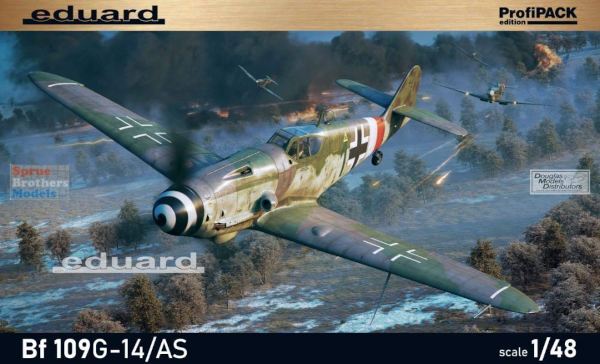
Eduard Bf109G-14/AS ProfiPACK
By Jacob Russell
The Messerschmitt Bf109G-4/AS was developed to intercept enemy aircraft at higher altitudes, entering service with the Luftwaffe in July of 1944. The G-14/AS was converted from standard G-6 aircraft. Some were equipped with the MW-50 (Methanol/Wasser) system and the DB 605AM engine. Others used the FuG 16zy radio set with a Morane antenna underneath the fuselage; these were designated G-14/AS/y and served as high altitude command fighters.
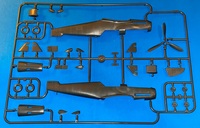
|
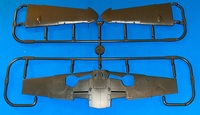
|
Eduard's reissued ProfiPACK kit comes in their customary stout box with cool artwork of a Bf109/AS fighter engaged in low altitude, treetop level battle with a Spitfire Mk. IX. The kit consists of 244 parts. 200 of these are plastic on 5 sprues, 43 parts are photo-etch on a single fret plus a sheet of rice paper masks.
The surface detail on the wings and fuselage consists of recessed panel lines and rivets and this detail is superb. The wheel wells are deep, multi-piece moldings that are convincing. The leading edge slats are separate pieces. The ailerons, under wing radiator flaps and horizontal stabilizers are also individual pieces. The fabric effect on the ailerons, rudder and horizontal stabilizers is good. The landing gear are well executed.
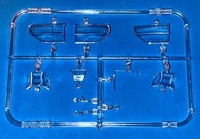
|
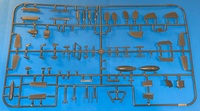
|
The multi-piece cockpit will look great with an oil wash and some careful drybrushing. The landing gear, gear doors, drop tank, etc. all look good, too.
Optional parts include a number of Rüstsatze (field conversion sets): R-1 (ETC 900/IXb rack with SC 250 bomb), R-2 (ETC 50/VIId rack with 4 SC 50 bombs), R-3 (300 liter drop tank), R-6 (MG 151/20MM under wing cannon) and R-7 (Direction Finding (DF) loop). These parts are nice to have and very useful.
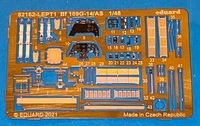
|
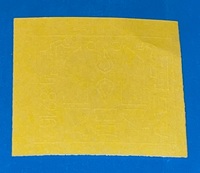
|
The clear parts include 2 gun sights, 3 different windscreens, the fuel line, "Galland Panzer" canopy armor and 3 different Erla Haube canopies.
Eduard's decals are crisp, with bright colors and good registration. There are 2 sheets, including 2 sets of air frame stencils. There are 5 different aircraft options:
"Green 1", W. Nr. 784938, III./JG 6, Bissel, Germany, January 1945. The camouflage was in late War colors of RLM 75 and 82 over 76 with a moderate 75/82 mottle, the spinner was black with a white spiral and black/white spinner backing plate. This Bf109 also had an RLM 23 Red and white fuselage band.
"Yellow 15", W. Nr. 783891, Fw. Heinz-Paul Müller, 9./JG 300, Jüterbog-Damm, Germany, autumn 1944. The camouflage was RLM 75/82/76 with a sparse 75/82 mottle, the spinner was black with a white spiral, an RLM 70/white spinner backing plate and an RLM 23 Red fuselage band. The rudder had large RLM 76 mottles.
"Yellow 1", Lt. Walter Köhne, 9./JG 300, Jüterbog-Damm, Germany, autumn 1944. The camouflage was RLM 75/82/76 with a sparse 75/82 mottle, the spinner was black with a white spiral and an RLM 70/white spinner backing plate. The rudder had large RLM 76 mottles. The fuselage national insignias had an RLM 82 "fill" plus there was an RLM 04 Yellow fuselage band.
"Black 17", W.Nr. 785185, Lt. Heinz Schüler, 16./JG 5, Stavanger-Forus, Norway, March 1945. The camouflage was RLM 75/82/76 with a loose 75/82 mottle, the plane had a black spinner with a white spiral and an RLM 70/white spinner backing plate. The rudder had large RLM 76 mottles. This G-14/AS also had the tall tailwheel.
W. Nr. 785083, Sgt. Magg, Aroldo Burei, 1ª Squadriglia, 1° Gruppo, Caccia ANR, Malpensa, Italy, April 1945. The camouflage was RLM 75/82/76 with a loose 75/82 mottle and the plane had a black spinner with a white spiral and an RLM 70/white spinner backing plate.The fin, rudder and aft fuselage were overpainted with light gray with fat RLM 70 squiggles. Much of the lower wings were natural metal.
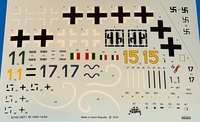
|

|
The instructions are up to Eduard's usual standards. The instructions include a parts map, a well illustrated and logical build sequence, full color profiles of all 5 decal options and a stencil application guide. Color call outs are for GSI Creos (Gunze) Aqueous, Mr. Color and Mission Models paints.
The G-14/AS Weekend has 5 exciting decal options and you have your pick of the various Brassin, Löök, Space and PE sets if you want to add some additional detail. I recommend this Bf109 kit and I would like to thank Eduard for the review sample.
References
Bf109 Late Versions, Camouflage & Markings, Krzysztof W. Woɫowski, MMP Books, 2010
